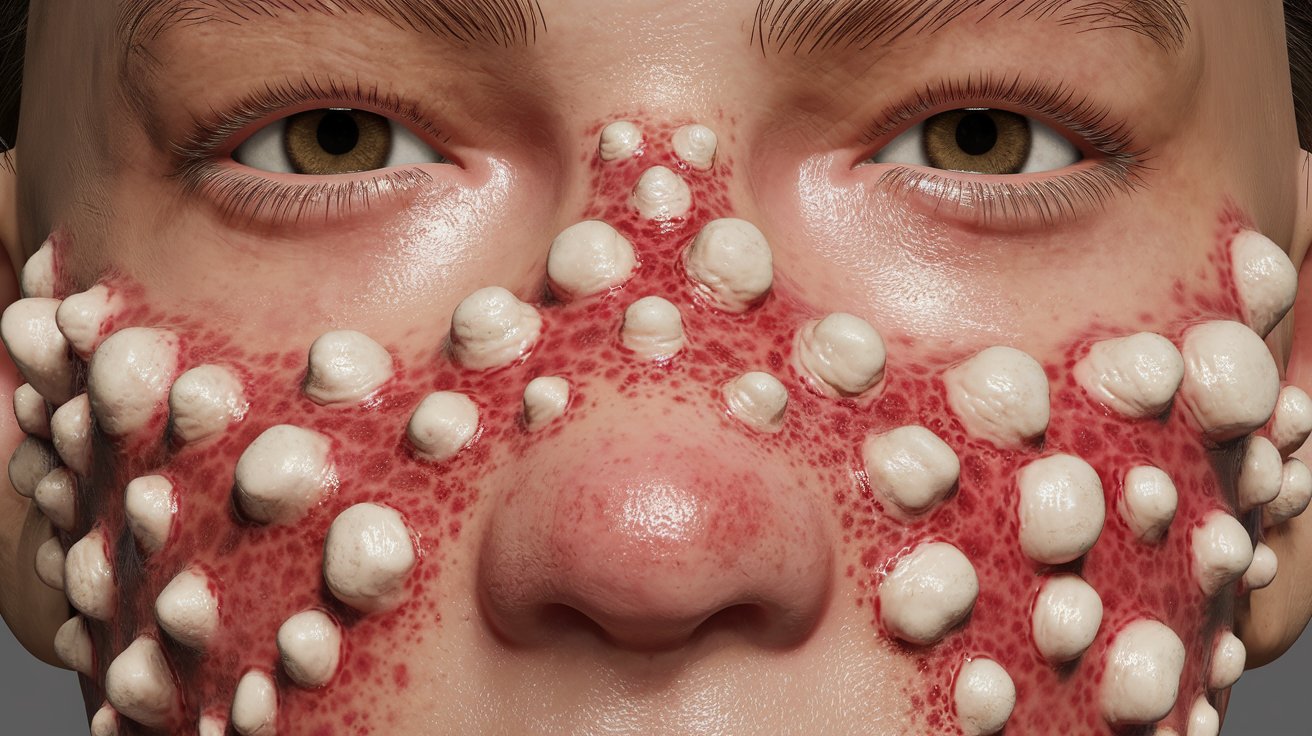
What is Omenn Syndrome? Omenn Syndrome is a rare, severe form of combined immunodeficiency (SCID). Infants with this condition often show symptoms within weeks of birth. These symptoms include a red rash, skin peeling, hair loss, chronic diarrhea, and enlarged lymph nodes and organs. The syndrome is caused by mutations in genes like RAG1 and RAG2, crucial for immune cell development. Without treatment, children with Omenn Syndrome face life-threatening infections and typically do not survive past age two. Early diagnosis and bone marrow transplantation are essential for improving survival rates and quality of life.
Key Takeaways:
- Omenn Syndrome is a rare and severe form of combined immunodeficiency, characterized by skin manifestations, autoimmune features, and susceptibility to infections. Early diagnosis and bone marrow transplantation are crucial for improving survival rates.
- Genetic mutations in RAG1 and RAG2 genes lead to Omenn Syndrome, causing a profound deficiency in T and B lymphocytes. Understanding the genetic basis and early treatment with bone marrow transplantation are essential for managing this complex disorder.
What is Omenn Syndrome?
Omenn syndrome is a rare and severe form of combined immunodeficiency (SCID). It combines immunodeficiency and autoimmunity, making it a challenging condition to manage. Here are some key facts to help you understand this complex disorder.
-
Definition: Omenn syndrome is an autosomal recessive form of SCID, characterized by a partial loss of function in genes involved in V(D)J recombination, particularly the RAG1 and RAG2 genes.
-
Clinical Presentation: Infants with Omenn syndrome typically present within the first few weeks of life with symptoms such as erythroderma (a generalized red rash), desquamation (peeling of the skin), alopecia (hair loss), chronic diarrhea, lymphadenopathy (enlarged lymph nodes), and hepatosplenomegaly (enlarged liver and spleen).
Skin and Autoimmune Features
The skin and autoimmune features of Omenn syndrome are particularly striking and often lead to early diagnosis.
-
Skin Manifestations: The skin manifestations in Omenn syndrome are particularly striking, often mistaken for eczema but characterized by a pachydermatis appearance that progresses to desquamation.
-
Autoimmune Features: The condition is also marked by autoimmunity, where the immune system attacks the body's own tissues and organs. This can lead to very red skin (erythroderma), hair loss (alopecia), and an enlarged liver and spleen (hepatosplenomegaly).
Immune Deficiency and Infections
Omenn syndrome severely impacts the immune system, making patients highly susceptible to infections.
-
Immune Deficiency: Individuals with Omenn syndrome have a profound deficiency in both T and B lymphocytes, making them highly susceptible to infections with common pathogens such as bacteria, viruses, and fungi.
-
Elevated IgE Levels: One of the hallmark features of Omenn syndrome is the elevation of immunoglobulin E (IgE) levels, which is often accompanied by eosinophilia (an increase in eosinophils, a type of white blood cell).
Genetic Causes and Mutations
Understanding the genetic basis of Omenn syndrome is crucial for diagnosis and treatment.
-
Genetic Causes: The majority of cases are caused by mutations in the RAG1 and RAG2 genes, which are essential for V(D)J recombination in T and B lymphocytes. However, other genes such as ARTEMIS, ADA, IL2Rγ, and IL7Rα can also be implicated.
-
Heterogeneity: Omenn syndrome is now recognized as a genetically heterogeneous condition, where patients with similar phenotypes may have unidentified genetic defects.
-
Missense Mutations: Approximately half of the mutations associated with Omenn syndrome are missense mutations, which result in partial loss of function of the affected gene.
-
Nonsense Mutations: The remainder of the mutations include nonsense, deletion, frameshift, and splice mutations, which also lead to impaired immune function.
-
Chromosome Location: The RAG1 and RAG2 genes are located on chromosome band 11p13.
Clinical Findings and Symptoms
The clinical findings in Omenn syndrome are diverse and often severe.
-
Clinical Findings: Infants with Omenn syndrome often present with life-threatening infections, including pneumonia and chronic diarrhea caused by opportunistic pathogens.
-
Failure to Thrive: Chronic diarrhea and repeated infections lead to failure to thrive, which is a common feature in SCID patients.
-
Lymphadenopathy: Lymphadenopathy is a distinguishing feature of Omenn syndrome, often presenting with enlarged lymph nodes.
-
Hepatosplenomegaly: Hepatosplenomegaly is also characteristic, with the liver and spleen being significantly enlarged.
Infections and Complications
Infections are a major concern for patients with Omenn syndrome.
-
Infections: Patients are prone to severe infections, including Pneumocystis carinii pneumonia and poliomyelitis due to attenuated oral poliovirus.
-
Sepsis: Staphylococcus aureus sepsis and gram-negative enteric bacterial sepsis are common complications due to chronic diarrhea.
Auto-Reactive T Cells and Th2 Skewing
The immune system's malfunction in Omenn syndrome leads to unique cellular characteristics.
-
Auto-Reactive T Cells: The condition is characterized by the presence of oligoclonal-activated T cells that are auto-reactive, contributing to the autoimmune features.
-
Th2 Skewing: There is a skewing towards Th2 cells, which produce elevated levels of interleukin 4 (IL-4) and interleukin 5 (IL-5), leading to eosinophilia and elevated IgE levels.
Diagnostic Methods and Genetic Testing
Diagnosing Omenn syndrome involves a combination of clinical evaluation and genetic testing.
-
Diagnostic Methods: Diagnosis typically involves genetic testing to identify mutations in the RAG1 and RAG2 genes or other implicated genes. A genetic testing panel may also include 22q11 microdeletions.
-
Genetic Testing: Genetic testing is crucial for diagnosing Omenn syndrome, particularly for identifying homozygous or compound heterozygous mutations in the RAG1 and RAG2 genes.
Immunological and Histological Features
The immunological and histological features provide further insights into the condition.
-
Immunological Features: Infants with Omenn syndrome exhibit hypogammaglobulinemia (low levels of immunoglobulins) and a decreased number of B cells, reflecting the profound immune deficiency.
-
Histological Findings: Lymph node specimens show architectural effacement, lymphocyte depletion, and histiocytic hyperplasia, which are characteristic features.
-
Serum IgE Levels: Serum IgE levels are elevated in some cases but can be low or undetectable in others, reflecting the variability in immune function.
Treatment and Outcomes
Treatment options for Omenn syndrome are limited but can be life-saving.
-
Bone Marrow Transplantation: The only effective treatment for Omenn syndrome is bone marrow transplantation (BMT), which aims to restore normal immune function.
-
Treatment Outcomes: BMT is usually successful, but life-threatening acute or chronic graft-versus-host disease (GVHD) can be a complication.
-
GVHD Risk: GVHD is a significant risk following BMT, necessitating careful monitoring and management.
-
Chronic GVHD: Chronic GVHD can occur in any stem cell reconstitution procedure, including BMT for Omenn syndrome.
Survival Rate and Prevalence
Understanding the survival rate and prevalence helps in grasping the impact of Omenn syndrome.
-
Survival Rate: Without treatment, children with Omenn syndrome typically survive only until age 1 or 2 due to the severe immunodeficiency and associated infections.
-
Prevalence: The exact prevalence of Omenn syndrome is unknown, but all forms of SCID are estimated to affect 1 in 75,000 to 100,000 newborns.
Global Distribution and Demographics
Omenn syndrome affects individuals worldwide, with no gender preference.
-
Global Distribution: Cases have been reported from throughout the world, with a higher incidence in North America and Europe.
-
Demographics: The incidence is equal among male and female infants, consistent with the autosomal recessive etiology of Omenn syndrome.
Age of Presentation and Early Symptoms
The age of presentation and early symptoms are critical for timely diagnosis.
-
Age of Presentation: Infants typically present within weeks of birth, with symptoms often developing by age 3 months.
-
Early Symptoms: Early symptoms include erythroderma, diarrhea, and failure to thrive, which precede the onset of life-threatening infections.
Infectious and Autoimmune Complications
Complications from infections and autoimmunity are common in Omenn syndrome.
-
Infectious Complications: Infectious complications include pneumonia, sepsis, and poliomyelitis due to attenuated oral poliovirus, highlighting the severe immunodeficiency.
-
Autoimmune Complications: Autoimmune complications such as skin rash and hair loss are also common, reflecting the auto-reactive nature of the immune response.
Immune Function Analysis and RAG Gene Mutations
Analyzing immune function and understanding RAG gene mutations are key to managing Omenn syndrome.
-
Immune Function Analysis: Immune function analysis reveals a profound deficiency in both T and B lymphocytes, with impaired V(D)J recombination.
-
RAG Gene Mutations: Mutations in the RAG1 and RAG2 genes result in partial loss of function, leading to the characteristic features of Omenn syndrome.
Genetic Heterogeneity
The genetic heterogeneity of Omenn syndrome means that multiple genes can be involved.
-
Genetic Heterogeneity: The condition is genetically heterogeneous, with mutations in other genes such as ARTEMIS, ADA, IL2Rγ, and IL7Rα also contributing to the Omenn phenotype.
-
Conclusion: Omenn syndrome is a rare and severe form of SCID characterized by a combination of immunodeficiency and autoimmunity. The condition is typically diagnosed in infancy and is associated with significant morbidity and mortality if left untreated. Early diagnosis through genetic testing and prompt treatment with bone marrow transplantation are crucial for improving survival rates and quality of life for affected individuals.
Final Thoughts on Omenn Syndrome
Omenn syndrome is a rare, severe form of combined immunodeficiency that affects infants, leading to life-threatening infections and autoimmune issues. Caused by mutations in genes like RAG1 and RAG2, this condition presents with symptoms such as erythroderma, alopecia, and hepatosplenomegaly. Early diagnosis through genetic testing is crucial. Without treatment, affected children often don't survive past age 2. The only effective treatment is bone marrow transplantation, which can restore immune function but carries risks like graft-versus-host disease. Awareness and understanding of Omenn syndrome are vital for early intervention and improving survival rates. This condition, though rare, highlights the importance of genetic research and advanced medical treatments in combating severe immunodeficiencies.
Frequently Asked Questions
Was this page helpful?
Our commitment to delivering trustworthy and engaging content is at the heart of what we do. Each fact on our site is contributed by real users like you, bringing a wealth of diverse insights and information. To ensure the highest standards of accuracy and reliability, our dedicated editors meticulously review each submission. This process guarantees that the facts we share are not only fascinating but also credible. Trust in our commitment to quality and authenticity as you explore and learn with us.


